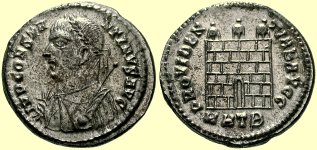
Constantine I 306-337 A.D.
By clicking on the pictures you'll be linked to a more complete description of the coin. At the bottom of this page there is a more elaborate biography of the emperor.
 |
Obverse: IMP CONSTANTINVS AVG |
| Reverse: PROVIDENTIAE AVGG | |
|
Fieldmarks: -
|
|
| Exergue: MHTβ |
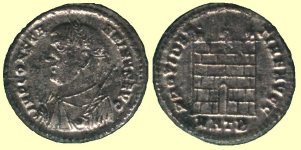 |
Obverse: IMP CONSTANTINVS AVG |
| Reverse: PROVIDENTIAE AVGG | |
|
Fieldmarks: -
|
|
| Exergue: MHTβ |
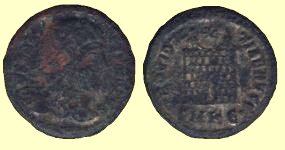 |
Obverse: CONSTANTINVS AVG |
| Reverse: PROVIDENTIAE AVGG | |
|
Fieldmarks: -
|
|
| Exergue: SMKε |
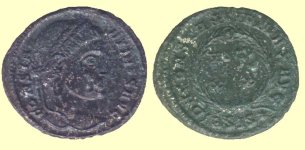 |
Obverse: CONSTANTINVS AVG |
| Reverse: DN CONSTANTINI MAX AVG (VOT XX) | |
|
Fieldmarks: -
|
|
| Exergue: ΔSIS* |
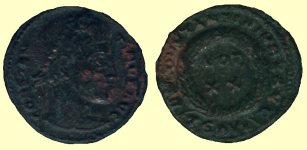 |
Obverse: CONSTANTINVS AVG |
| Reverse: DN CONSTANTINI MAX AVG (VOT XX) | |
|
Fieldmarks: -
|
|
| Exergue: TSAVI |
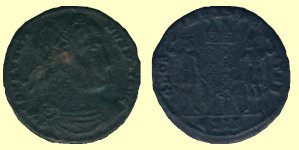 |
Obverse: CONSTANTINVS MAX AVG |
| Reverse: GLORIA EXERCITVS | |
|
Fieldmarks: -
|
|
| Exergue: εSIS |
 |
Obverse: CONSTANTINVS MAX AVG |
| Reverse: GLORIA EXERCITVS | |
|
Fieldmarks: -
|
|
| Exergue: RBP |
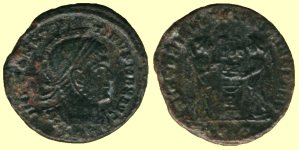 |
Obverse: IMP CONSTANTINVS MAX AVG |
| Reverse: VICTORIAE LAETAE PRINC PERP / VOT PR | |
|
Fieldmarks: an R inscribed on the altar on the reverse
|
|
| Exergue: PT |
 |
Obverse: DV CONSTANTINVS PT AVGG |
| Reverse: - | |
|
Fieldmarks: -
|
|
| Exergue: SMKε |
Constantine I 306-337 A.D.
Flavius Valerius Constantinus was born on the 27th of February around the year 272 (the exact year is not known), at Naissus in the province of Moesia Superior. His father was a military officer named Constantius Chlorus (Constantius I), his mother was a woman from a humble background named Helena. It is unclear if the two were married and so Constantine may well have been an illegitimate child. Constantius Chlorus was raised, on the 1st of March 293, to the rank of Caesar in the First Tetrarchy organized by Diocletian. On this occasion he was required to put aside Helena and to marry Theodora, the daughter of Maximianus (the emperor of the east at that time). Upon the retirement of Diocletian and Maximianus on the 1st of May 305 Constantius Chlorus was elevated to the rank of Augustus of the western part of the empire while Galerius became the emperor of the eastern part of the empire.
Constantine, in the meanwhile, had served as an officer under both Diocletian and Galerius where he showed much promise while campaigning against the Persians. Constantine was kept at the court of Galerius as a pledge of good conduct on his father's part. Later when Constantius Chlorus was preparing for a military campaign against barbarians who had crossed Hadrian's Wall in Britannia he asked Galerius to send Constantine back to him. Galerius was reluctant to let the young man go to his father, where his popularity with the army might undermine Galerius' authority. When Galerius grudgingly gave his permission, Constantine immediately took off by night on fast horses. Thanks to the excellent Roman military roads, they were on the coast of Gaul boarding his father's ships before Galerius could change his mind and have the popular young man pursued and recalled. Galerius' fears where soon to be confirmed. When Constantius Chlorus became ill and died at the Roman military center of Eboracum in 306 A.D., the British troops immediately proclaimed Constantine emperor of Britannia. Galerius was enraged, but Constantine quickly wrote to tell him that he had had nothing to do with it and that he was forced by his troops. Since Constantine was far away and supported by an army, Galerius relented and agreed to give him the title of Caesar and he raised another man, Severus II, to the rank of Augustus in the West to replace Constantius Chlorus. Having settled affairs in Britannia, Constantine returned to the Continent, where the city of Treverorum served as his principal residence for the next six years. There, in 307, he married Maximian's daughter Fausta, putting aside his mistress Minervina, who had borne him his first son, Crispus. A few months later, the citizens of Italy rebelled and named Maxentius, the popular son of Maximianus their emperor. Galerius had increased their taxes and had removed the tax-exempt status Rome had enjoyed since the days of the Republic. Maxentius then invited his father to come out of retirement and rejoin him as co-emperor. Soon the two rebels were joined by Constantine, who was again claiming the title of Augustus. Galerius sent Severus II to deal with the rebels but Severus was defeated and later put to death by Maximianus. Things had gotten so bad by this time that the Roman Empire was in danger of returning to the anarchy and civil war of the Third Century, Diocletian agreed to come out of retirement and chair a peace conference at the military town of Carnuntum on the Danube. According to the agreement, Constantine was to be demoted to the rank of Caesar and Valerius Licinianus Licinius was made Augustus in the West. Additionally, Maximianus was forced again to abdicate and Maxentius was declared an enemy of the people.
When Galerius died in AD 311 the main authority amongst the emperors had been removed, leaving the others to struggle for dominance. In the east Licinius and Maximinus Daia fought for supremacy and in the west Constantine began a war with Maxentius. In 312 AD Constantine invaded Italy. Maxentius is believed to have had up to four times as many troops, though they were inexperienced and undisciplined. Winning easy victories in battles at Augusta Taurinorum and Verona, Constantine marched on Rome. The final showdown with Maxentius came in 312 AD at the Milvian Bridge. Constantine had made an alliance with Licinius in order to bring more troops against his rival, and easily won this battle. This was a significant event in Constantine's religious development. It is said that during the night before the Battle of the Milvian Bridge Constantine saw in a dream the sign of Christ (the Chi-Rho) and a message written in Latin reading IN HOC SIGNO VINCES, meaning "In this sign shalt thou conquer." He immidiately ordered the symbol to be placed on the shields of his soldiers and the standards. Whatever vision Constantine may have experienced, he attributed his victory to the power of "the God of the Christians" and committed himself to the Christian faith from that day on. Maxentius, thrown from the Milvian Bridge, was drowned when the weight of his armor caused him to sink into the muck at the bottom of the River Tiber. His body was recovered the day after the battle and this victory made Constantine the sole ruler of the western half of the empire.
Now that Constantine was the dominant figure in the empire the senate warmly welcomed him to Rome and the two remaining emperors, Licinius and Maximinus II Daia could do little else but agree to his demand that he henceforth should be the senior Augustus. Despite his turn toward Christianity, Constantine remained for some years still very tolerant of the old pagan religions. Particularly the worship of Mars and Sol Invictus the sun god. A fact which can be seen on the carvings of Constantine's triumphal Arch in Rome and on coins minted during his reign. The arch was built for Constantine's decennalia (the tenth anniversary of his acclamation). There were all manner of festivities, but Constantine did not perform the traditional sacrifices to the pagan gods. In February 313 Constantine and Licinius met at Mediolanum. On this occasion Constantine's half-sister Constantia was wed to Licinius, and the two emperors formulated a common religious policy, known as the Edict of Milan. Unlike Constantine, Licinius did not commit himself personally to Christianity; even his commitment to toleration eventually gave way to renewed persecution of Christians.
Despite the conference at Milan the ultimate goal pursued by both Constantine and Licinius was sole power. The agreement of 313 had been born out of necessity, not of mutual good will. Even Constantia's apparent devotion to Licinius did little to ease the strained relationship between the two rivals. Open hostilities finally erupted in 316. In the course of this first war between the two emperors two battles were fought: the first at Cibalae in Pannonia the second on the campus Ardiensis in Thracia. In the first battle Licinius' army suffered heavy losses; in the second neither side won a clear victory. After this defeat a settlement left Licinius in his position as Augustus, but required him to cede to Constantine all of his European provinces other than Thrace. On the 1st of March 317, at Serdica, Constantine announced the appointment of three Caesars: his own son's Crispus, about twelve years old, and Constantine (later Constantine II), less than seven months old, and Licinius' son, named Licinius II, twenty months old. This peace however was fragile and tensions quickly grew again, in part because the two Augusti pursued different policies in matters of religion, and in part because the old suspicions surfaced again. Thus war erupted again in 324 over an incident in which Licinius chased some raiding barbarians into territory ruled by Constantine. Constantine defeated Licinius twice, first at Adrianopolis in Thrace, and then at Chrysopolis on the Bosporus. Initially, yielding to the pleas of Constantia, Constantine spared the life of his brother-in-law, but some months later he ordered his execution. Before too long the younger Licinius, too, fell victim to Constantine's anger or suspicions. Constantine was now the sole and undisputed master of the Roman world.
Another major event of Constantine's reign besides his turn towards Christianity was that Constantine refounded the ancient Greek city of Byzantium as Constantinople and made it the new capital of the empire. Constantinople enjoyed a most favorable location which afforded easy access to both the Balkan provinces and the eastern frontier, it controlled traffic through the Bosporus, and met all conditions for favorable economic development. On the 8th November 324 AD, less than two months after his victory over Licinius at Chrysopolis, Constantine formally laid out the boundaries of his new city, roughly quadrupling its territory. By 328 the new walls were completed, and on the 11th of May 330 AD the new city was formally dedicated. Coins showing the helmeted personification of Constantinople were struck to commemorate the joyous event. Constantine began the construction of two major churches in Constantinople, Hagia Sophia (Holy Wisdom) and Hagia Eirene (Holy Peace); the foundation of a third, the Church of the Holy Apostles (where he would be buried), may be attributed to him with a measure of certainty. Unlike the old Rome, which was filled with pagan monuments and institutions, the New Rome was essentially a Christian capital, although not all traces of its pagan past had been eliminated. An example of this is the so-called Column of Constantine, in the Forum of Constantine, built of porphyry and 25 m. high; its remains are now known as the Burnt Column. It was crowned by a statue of Helios, its features suitably adapted so as to suggest Constantine himself.
At some time in 326 Constantine ordered the execution of his oldest son Crispus, who had been appointed Caesar in 317, and had played a major role in the campaign against Licinius. In the same year, soon after the death of Crispus, Constantine also brought about the death of Fausta, the mother of his other three sons. A connection between the two deaths is likely. It is said that Crispus was involved with his stepmother Fausta. It is impossible now to separate fact from fiction and to know with certainty what offenses Crispus and Fausta had committed. Both of them suffered damnatio memoriae and were never rehabilitated. Some involvement of Helena in this family tragedy cannot be excluded as it might have been a ploy of her to get her own sons in a position of power instead of Crispus.
Several other important changes took place during Constantine's reign. One notable change pertained the praetorian prefects; these now became civilian ministers assisting the Augustus or the Caesars and they were thus effectively eliminated as a significant power. Their army was disbanded and their place was taken by the mounted guard, largely consisting of Germanic troops, who had been introduced as a bodyguard under Diocletians army reforms. Constantine continued these reforms, reaffirming the difference between frontier garrisons and mobile forces. The mobile forces consisting largely of heavy cavalry which could quickly move to trouble spots. The presence of Germanic troops continued to increase during his reign. In the course of a successful reform of the currency Constantine also instituted a new type of coin, the gold solidus, which won wide acceptance and remained the standard for centuries to come. Constantine was also important in the history of the Catholic Church for his role at the Council of Nicaea in 325 AD. He presided over this Council where Bishops from all over the Roman world gathered together to have Constantine help them decide on the nature of God. They worked out the doctrine of the Holy Trinity, in which Father, Son, and Holy Ghost were found to be equal persons in one God. Also, the Arian heresy was denounced at the Council of Nicaea they believed that Jesus Christ was somehow of a lesser importance, and had been created by, God the Father. During his reign Constantine did not neglect the security of the frontiers. He campaigned successfully in 306-308 and 314-15 on the German frontier. This was followed in late 332 AD by a large campaign against the Goths along the Danube which lasted until 336 AD when he had re-conquered much of Dacia, once annexed by Trajan and abandoned by Aurelian.
The arrangements which Constantine
made for his own succession were quite unsatisfactory. During the last two
years of his reign there were four Caesars: his sons Constantine (II), Constantius
(II), and Constans, having been appointed in 317, 324, and 333 respectively,
and his nephew Flavius Dalmatius (whose father,
of like name, was a son of Constantius I and Theodora), appointed in 335.
It is not clear which of these Caesars Constantine intended to take precedence
upon his death. In old age now, Constantine planned a last great campaign,
one which was intended to conquer Persia. Shortly after Easter 337 Constantine
began to feel ill. He traveled to Nicomedia
where on the 22nd of May 337 AD he died, still wearing the white robes of
a Christian neophyte, as he was baptized right before his death. His body
was escorted to Constantinople
and lay in state in the imperial palace. His sarcophagus was then placed in
the Church of the Holy Apostles, as he himself had directed; it was surrounded
by the memorial steles of the Twelve Apostles, making him symbolically the
thirteenth Apostle. Had his own wish to be buried in Constantinople caused
outrage in Rome, the Roman senate still decided on his deification. A strange
decision as it elevated him, the first Christian emperor, to the status of
an old pagan deity. Only on the 9th of September did Constantine
II, Constantius II, and Constans
each assume the rank of Augustus, after all possible rivals, including the
fourth Caesar, Flavius Dalmatius, had been eliminated in a bloody coup.
For this biography I've used the texts from the following websites:
http://www.imperiumromanum.com/
http://www.roman-emperors.org/
http://www.roman-empire.net/
And from: Gibbon's Decline and fall of the Roman empire.